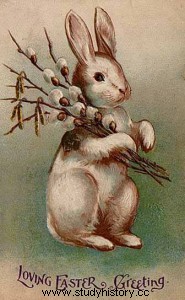 Candy eggs, painted and adorned with multicolored applications, fill the shelves of the main supermarkets in Lima during the season of Holy Week. As is often the case with ancient traditions in our times, the Easter Eggs they have become just an object to be sold these days, and hardly anyone maintains the custom of hiding them at home, much less associated with the Easter Bunny, who distributes these symbolic and colorful gifts. Halfway between the Jewish Passover and a story deeply linked to the resurrection of Jesus Christ, the basis on which the Christian creed is built, this tradition is very interesting. In this note we tell you in detail the story behind the famous Easter Eggs and the mysterious Rabbit, its various meanings and origins:
Candy eggs, painted and adorned with multicolored applications, fill the shelves of the main supermarkets in Lima during the season of Holy Week. As is often the case with ancient traditions in our times, the Easter Eggs they have become just an object to be sold these days, and hardly anyone maintains the custom of hiding them at home, much less associated with the Easter Bunny, who distributes these symbolic and colorful gifts. Halfway between the Jewish Passover and a story deeply linked to the resurrection of Jesus Christ, the basis on which the Christian creed is built, this tradition is very interesting. In this note we tell you in detail the story behind the famous Easter Eggs and the mysterious Rabbit, its various meanings and origins:
The rabbit that brought the Easter eggs was first mentioned by the German botanist and researcher Georg Frank Von Frankenau in his book De Ovispaschalibus or About the Easter Eggs , in which he tells us how, according to an old tradition from the Alsace region, in dispute between France and Germany for several centuries (after the Second World War it became part of France definitively), this animal carried a basket filled with sweets and colored eggs to the homes of all children.
In De Ovispaschalibus, Von Frankenau explains that Easter Eggs They are considered pagan symbols of life and fertility and are related to the Easter festival. In a passage from his publication, which appeared in the 17th century, the scholar mentions:“In Alsace and the surrounding regions, these eggs have always been attributed to the rabbit to make simple people and children believe that the Easter bunny hidden among the grass in the gardens with the aim that they are later enthusiastically sought after by toddlers and this generates an atmosphere of delight and happiness for all”.
In people's imagination, the rabbit and the hare have They have always been the most fertile animals that exist, which is why they are related to the distribution of eggs that symbolize life. But why does the distribution of the eggs coincide with the Christian religious festival we know as Easter?
Rabbits and hares, like many mammals, hibernate during the winter and do not let themselves be seen, but when they start When the first rays of light appear in the spring season (in Europe Easter is celebrated in spring), these little animals appear again, coming out of their hiding places to run through the meadows. Easter is the celebration of the Passion of Christ, which also coincides with spring, hence the relationship between rabbits, their eggs and Easter.
Initially, in the Middle Ages, feudal lords gave eggs to their employees during this religious celebration. The eggs were adorned with bright colors that symbolized the arrival of the first spring winds. Eggs were also given as offerings to churches after being decorated with multiple colors.
In Greece for example, eggs are painted red, which represents the blood of Jesus Christ on the cross. These eggs, as in the case of the traditions of other countries, also represent the return to life, the resurrection of the Son of God. In a traditional game of Greek culture called "Tsougrisma", two people with many eggs in their possession each, face each other trying to hit the red eggs that the opponent is carrying in his hand, in order to break them. The winner will be the one who, at the end of the confrontation, has the fewest broken eggs and will be rewarded with good fortune throughout the year.
In Asturias, Spain, in the towns of Pola de Siero and Sama de Langreo The festival of the painted eggs is celebrated on the Tuesday that follows Easter Sunday. In this traditional festival in the north of Spain, eggs painted and decorated by hand by artisans from the region are exhibited, sold and given away. Asturians dress up in traditional costumes and attend the feast of the blessing of the eggs known as the painted eggs.
A Christian legend tells that, when Jesus was placed in his tomb after he died, inside the cave there was a frightened rabbit before the crowd of people who accompanied the body of Christ. When the Christian retinue withdrew, the rabbit, absorbed, began to wonder who this man was for whom so many people were crying. When the resurrection of the son of God took place, the rabbit watched as an angel removed the stone with which they had blocked the entrance to the tomb of Christ.
This Christian fable tells that the rabbit understood what had happened, but as unable to speak, she decided she would spread the good news by taking colorfully painted eggs to every house. These eggs would represent the return to life of the Messiah and the message of joy and peace that characterizes religion.
